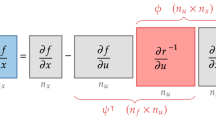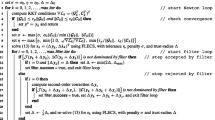Abstract
The adjoint method provides an efficient way to compute sensitivities for system models with a large number of inputs. However, implementing the adjoint method requires significant effort that limits its use. The effort is exacerbated in large-scale multidisciplinary design optimization. We propose the adoption of a three-stage compiler as the method for constructing computational models for large-scale multidisciplinary design optimization to enable accurate and efficient adjoint sensitivity analysis. We develop a new modeling language called the Computational System Design Language that provides an appropriate input to the compiler front end that works well with multidisciplinary models. This paper describes the three-stage compiler methodology and the Computational System Design Language. The proposed solution uses a graph representation of the numerical model to automatically generate a computational model that computes adjoint-based sensitivities for use within an optimization framework. For two engineering models, this approach reduces the amount of user code by a factor of approximately two compared to their original implementations, without a measurable increase in computation time. This paper also includes a best-case complexity analysis that is built into the compiler implementation to allow users to estimate the memory required to evaluate a computational model and its derivatives, which is independent of the compiler back end that ultimately generates the computational model. Future compiler implementations are expected to approach the theoretical best-case memory cost and improve run time performance for both model evaluation and derivative computation.














Similar content being viewed by others
Data availability
No datasets were generated or analysed during the current study.
Notes
Another AD library that supports implicit differentiation in Julia is available at https://gdalle.github.io/ImplicitDifferentiation.jl/.
The term “graph-based” here refers to a property of languages, and not a property of the methodology presented in this paper.
There are two modes when solving the UDE: forward mode and reverse mode. Forward mode corresponds to using the direct method and reverse mode corresponds to using the adjoint method.
This is the same as the concept of a model within the Problem class in OpenMDAO.
The derivative implementation for external code may be inexact due to limitations in how the external code was implemented.
Another AD library that supports implicit differentiation is available at https://gdalle.github.io/ImplicitDifferentiation.jl/.
This assumes the existence of a compiler back end that can support code generation for a particular architecture, which is not the case at the time of writing.
Back ends that generate code in these languages do not currently exist, but can be developed to use CSDL GraphRepresentation objects generated by the CSDL compiler front end.
Execution of individual vectorized operations may be further parallelized, reducing computation time by more than what is shown in Fig. 8.
References
Åkesson J (2008) Optimica—an extension of modelica supporting dynamic optimization. In: 6th international modelica conference, pp 57–66
Alnæs MS, Mardal K-A (2010) On the efficiency of symbolic computations combined with code generation for finite element methods. ACM Trans Math Softw 37(1):1–26
Alnæs MS, Mardal K-A (2012) SYFI and SFC: symbolic finite elements and form compilation. Springer, New York
Alnæs MS, Logg A, Ølgaard KB, Rognes ME, Wells GN (2014) Unified form language: a domain-specific language for weak formulations of partial differential equations. ACM Trans Math Softw 40(2):1–37
Baydin AG, Pearlmutter BA, Radul AA, Siskind JM (2018) Automatic differentiation in machine learning: a survey. J March Learn Res 18:1–43
Bezanson J, Edelman A, Karpinski S, Shah VB (2017) Julia: a fresh approach to numerical computing. SIAM Rev 59(1):65–98
Bisschop J, Meeraus A (1982) On the development of a general algebraic modeling system in a strategic planning environment. Springer, New York
Blondel M, Berthet Q, Cuturi M, Frostig R, Hoyer S, Llinares-López F, Pedregosa F, Vert JP (2022) Efficient and modular implicit differentiation. arXiv:2105.15183
Bradbury J, Frostig R, Hawkins P, Johnson MJ, Leary C, Maclaurin D, Necula G, Paszke A, VanderPlas J, Wanderman-Milne S, Zhang Q (2018) JAX: composable transformations of Python+NumPy programs. http://github.com/google/jax
Bussieck MR, Meeraus A (2004) General algebraic modeling system (GAMs). Springer, New York
Bynum ML, Hackebeil GA, Hart WE, Laird CD, Nicholson BL, Siirola JD, Watson JP, Woodruff DL (2021) Pyomo-optimization modeling in python, vol 67. Springer, Berlin
Carpenter B, Hoffman MD, Brubaker M, Lee D, Li P, Betancourt M (2015) The Stan math library: reverse-mode automatic differentiation in c++. arXiv preprint arXiv:1509.07164
Carpenter B, Gelman A, Hoffman MD, Lee D, Goodrich B, Betancourt M, Brubaker MA, Guo J, Li P, Riddell A (2017) Stan: a probabilistic programming language. J Stat Softw 76:1
Chauhan SS, Martins JRRA (2018) Low-fidelity aerostructural optimization of aircraft wings with a simplified wingbox model using OpenAeroStruct. Springer, New York
Cheng Z, Zhao S, Scotzniovsky L, Rodriguez G, Mi C, Hwang JT (2023) A differentiable method for low-fidelity analysis of permanent-magnet synchronous motors. In: AIAA SCITECH 2023 forum, p 1091
Dunning I, Huchette J, Lubin M (2017) Jump: a modeling language for mathematical optimization. SIAM Rev 59(2):295–320
Fishwick PA (1998) A taxonomy for simulation modeling based on programming language principles. IIE Trans 30(9):811–820
Fourer R, Gay DM, Kernighan BW (1990) A modeling language for mathematical programming. Manag Sci 36(5):519–554
Fritzson P, Engelson V (1998) Modelica—a unified object-oriented language for system modeling and simulation. In: ECOOP'’98—Object-Oriented Programming: 12th European Conference Brussels, Belgium, July 20–24, 1998 Proceedings 12. Springer, Berlin, pp 67–90
Gray J, Moore K, Naylor B (2010) Openmdao: an open source framework for multidisciplinary analysis and optimization. In: 13th AIAA/ISSMO multidisciplinary analysis optimization conference, vol 5
Gray JS, Hwang JT, Martins JR, Moore KT, Naylor BA (2019) Openmdao: an open-source framework for multidisciplinary design, analysis, and optimization. Struct Multidisc Optim 59(4):1075–1104
Ha TH, Lee K, Hwang JT (2020) Large-scale multidisciplinary optimization under uncertainty for electric vertical takeoff and landing aircraft. In: IAA Scitech 2020 forum, p 0904
Hart WE, Watson J-P, Woodruff DL (2011) Pyomo: modeling and solving mathematical programs in python. Math Program Comput 3(3):219–260
Hwang JT, Martins JR (2018) A computational architecture for coupling heterogeneous numerical models and computing coupled derivatives. ACM Trans Math Softw 44(4):1–39
Hwang JT, Ning A (2018) Large-scale multidisciplinary optimization of an electric aircraft for on-demand mobility. In: 2018 AIAA/ASCE/AHS/ASC structures, structural dynamics, and materials conference, p 1384
Jasa JP, Hwang JT, Martins JRRA (2018) Open-source coupled aerostructural optimization using Python. Struct Multidisc Optim 4:1815–1827
Kahn AB (1962) Topological sorting of large networks. Commun ACM 5(11):558–562
Kallrath J (2004) Modeling languages in mathematical optimization. Springer, New York
Kallrath J (2012) Algebraic modeling systems: modeling and solving real world optimization problems, 104. Springer, New York
Kirby RC, Logg A (2006) A compiler for variational forms. ACM Trans Math Softw 32(3):417–444
Lattner C, Adve V (2004) LLVM: a compilation framework for lifelong program analysis & transformation. In: International symposium on code generation and optimization, 2004. CGO 2004, pp 75-86. IEEE
Logg A, Ølgaard KB, Rognes ME, Wells GN (2012) FFC: the fenics form compiler. Springer, New York
Margossian CC (2019) A review of automatic differentiation and its efficient implementation. Wiley Interdiscip Rev 9(4):e1305
Margossian CC, Betancourt M (2021) Efficient automatic differentiation of implicit functions. arXiv preprint arXiv:2112.14217
Marriage C, Martins JR (2008) Reconfigurable semi-analytic sensitivity methods and mdo architectures within the pimdo framework. In: 12th AIAA/ISSMO multidisciplinary analysis and optimization conference, p 5956
Martins JR, Hwang JT (2013) Review and unification of methods for computing derivatives of multidisciplinary computational models. AIAA J 51(11):2582–2599
Martins JR, Sturdza P, Alonso JJ (2003) The complex-step derivative approximation. ACM Trans Math Softw 29(3):245–262
Mernik M, Heering J, Sloane AM (2005) When and how to develop domain-specific languages. ACM Comput Surv 37(4):316–344
Moses W, Churavy V (2020) Instead of rewriting foreign code for machine learning, automatically synthesize fast gradients. Curran Associates Inc., New York
Moses WS, Churavy V, Paehler L, Hückelheim J, Narayanan SH, Schanen M, Doerfert J (2021) Reverse-mode automatic differentiation and optimization of GPU kernels via enzyme. Association for Computing Machinery
Moses WS, Narayanan SH, Paehler L, Churavy V, Schanen M, Hückelheim J, Doerfert J, Hovland P (2022) Scalable automatic differentiation of multiple parallel paradigms through compiler augmentation. In: SC22: international conference for high performance computing, networking, storage and analysis, pp 1–18. IEEE
Ning A, McDonnell T (2023) Automating steady and unsteady adjoints: efficiently utilizing implicit and algorithmic differentiation. arXiv:2306.15243
Ølgaard KB, Wells GN (2010) Optimizations for quadrature representations of finite element tensors through automated code generation. ACM Trans Math Softw 37(1):1–23
Revels J, Lubin M, Papamarkou T (2016) Forward-mode automatic differentiation in Julia. arXiv preprint arXiv:1607.07892
Rognes ME, Kirby RC, Logg A (2010) Efficient assembly of h(div) and h(curl) conforming finite elements. SIAM J Sci Comput 31(6):4130–4151
Ruh ML, Hwang JT (2021) Robust modeling and optimal design of rotors using blade element momentum theory. In: AIAA Aviation 2021 forum, p 2598
Ruh ML, Hwang JT (2023) Fast and robust computation of optimal rotor designs using blade element momentum theory. AIAA J 61(9):4096–4111
Sarojini D, Ruh ML, Joshy AJ, Yan J, Ivanov AK, Scotzniovsky L, Fletcher AH, Orndorff NC, Sperry M, Gandarillas VE, Asher I (2023) Large-scale multidisciplinary design optimization of an evtol aircraft using comprehensive analysis. In: AIAA SciTech 2023 forum, p 0146
Sinha R, Paredis CJ, Liang V-C, Khosla PK (2001) Modeling and simulation methods for design of engineering systems. J Comput Inf Sci Eng 1(1):84–91
Squire W, Trapp G (1998) Using complex variables to estimate derivatives of real functions. SIAM Rev 40(1):110–112
Viklund L, Fritzson P (1995) Objectmath-an object-oriented language and environment for symbolic and numerical processing in scientific computing. Sci Program 4(4):229–250
Wang B, Sperry M, Gandarillas VE, Hwang JT (2022) Efficient uncertainty propagation through computational graph modification and automatic code generation. In: AIAA AVIATION 2022 forum, p 3997
Wang B, Orndorff NC, Sperry M, Hwang JT (2023) High-dimensional uncertainty quantification using graph-accelerated non-intrusive polynomial chaos and active subspace methods. In: AIAA AVIATION 2023 forum, p 4264
Wang B, Sperry M, Gandarillas VE, Hwang JT. Accelerating model evaluations in uncertainty propagation on tensor grids using computational graph transformations (under review)
Yang J (2021) Fastad: expression template-based c++ library for fast and memory-efficient automatic differentiation. arXiv preprint arXiv:2102.03681
Acknowledgements
The authors thank Marius Ruh, Jiayao Yan, and Luca Scotzionovsky for helping generate the data in Fig. 10.
Funding
This work was supported in part by the National Science Foundation under Grant no. 1936557 and NASA Grant number 80NSSC21M0070.
Author information
Authors and Affiliations
Contributions
V.G. led the development of the language and compiler presented in the paper and wrote the manuscript. A.J. and A.L. developed the standard library for the language presented in the paper. M.S. contributed to the development of the compiler presented in the paper. J.H. supervised the research and manuscript writing. All authors reviewed the manuscript.
Corresponding author
Ethics declarations
Conflict of interest
On behalf of all authors, the corresponding author states that there is no Conflict of interest.
Replication of results
Detailed documentation for the Computational System Design Language (CSDL) is available at the CSDL website, https://lsdolab.github.io/csdl/. Links to the GitHub repository containing the compiler implementation, including the CSDL compiler front end and compiler middle end (https://github.com/lsdolab/csdl) along with a list of links to available back ends are also provided within the CSDL website.
Ethical approval
Not Applicable.
Informed consent
Not Applicable.
Additional information
Responsible Editor: Nestor Queipo
Publisher's Note
Springer Nature remains neutral with regard to jurisdictional claims in published maps and institutional affiliations.
Rights and permissions
Springer Nature or its licensor (e.g. a society or other partner) holds exclusive rights to this article under a publishing agreement with the author(s) or other rightsholder(s); author self-archiving of the accepted manuscript version of this article is solely governed by the terms of such publishing agreement and applicable law.
About this article
Cite this article
Gandarillas, V., Joshy, A.J., Sperry, M.Z. et al. A graph-based methodology for constructing computational models that automates adjoint-based sensitivity analysis. Struct Multidisc Optim 67, 76 (2024). https://doi.org/10.1007/s00158-024-03792-0
Received:
Revised:
Accepted:
Published:
DOI: https://doi.org/10.1007/s00158-024-03792-0




